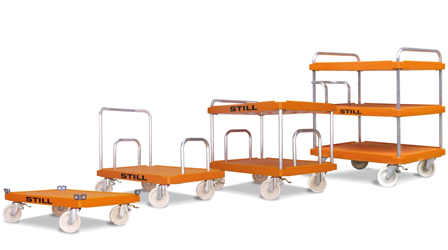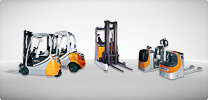Trolleys
Efficient production supply with tugger trains

Highlights
- Ease of operation, even with high loads, thanks to lower rolling resistance
- The wide range of trolley types for different load-carrying transportation makes it suitable for various applications
- Trolleys are fitted with two brakes as standard for safe operation
- Plastic table trucks with a low deadweight for easier handling come in a variety of different models
Steel trolleys
STILL steel trolleys are compatible with B-, C- and E-Frames and are available in different sizes depending on requirements. The standard height for pallet entry is 280 mm. A 450 mm height is also available, when an ergonomic working height is required for picking orders from the trolley. For precise positioning of the load carrier, trolleys can be fitted with removable pull handles and a braking system. For transportation in the LiftRunner tugger train system, trolleys are slid into the frames, automatically secured and raised up. This not only reduces running noise, but also roller wear-and-tear. By lifting the trolleys up during the journey, harder polyamide rollers can be used. This minimises rolling resistance, enabling higher loads to be moved more easily. Trolleys for carrying predominantly pallets or grid boxes are available in a variety of sizes and designs and can be tailor-made to requirements.
Plastic trolleys
Due to their low deadweight and smooth-running polyamide wheels, STILL plastic trolleys are suitable for work areas where employees have to push and pull heavy loads. They can be fitted with a push bar and specially smooth ball bearing rollers that support ergonomic posture when pushing or pulling. A sophisticated modular system - consisting of pallets and table or shelf-truck trolleys in different specifications – covers a variety of uses and applications. For transportation in the LiftRunner tugger train system, trolleys are slid into the frames at ground level, automatically secured and then lifted up either by hydraulics, pneumatics, electricity or autonomously, so that the tugger train has no contact with the ground during the journey. This not only reduces running noise, but also roller wear-and-tear.



